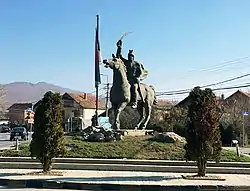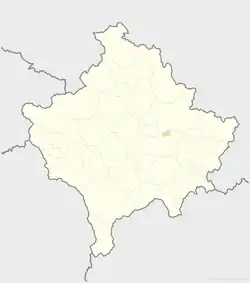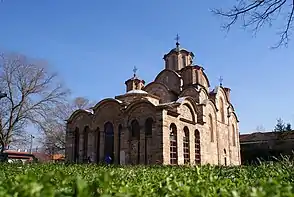Gračanica
| |
|---|---|
Town and municipality | |
 Center of Gračanica | |
 Flag  Emblem | |
 Gračanica  Gračanica | |
| Coordinates: 42°36′N 21°12′E / 42.600°N 21.200°E | |
| Country | Kosovo |
| District | District of Pristina |
| Settlements | 16 |
| Established | 29 December 2009[1] |
| Government | |
| • Provisional president | Ljiljana Šubarić (SL) |
| Area | |
| • Total | 131.25 km2 (50.68 sq mi) |
| Elevation | 588 m (1,929 ft) |
| Population (2011) | |
| • Total | 10,675 |
| • Density | 81/km2 (210/sq mi) |
| • Town | 4,500 |
| Time zone | UTC+1 (CET) |
| Postal code | 10500[2] |
| Area code | +383(0)38 |
| Website | Official site |
Gračanica (Serbian Cyrillic: Грачаница) or Graçanicë (Albanian definite form: Graçanica), is a town and municipality located in Pristina District in central Kosovo. As of 2011, it has an estimated population of 10,675 inhabitants, though most Serbs boycotted the Kosovo government's census.
It is centered around the Gračanica Monastery, ten kilometers east of Pristina. The 1999 Kosovo War and its aftermath transformed Gračanica from a sleepy village into an administrative center serving the needs of the 75,000 Kosovo Serbs living south of the Ibar River. After the 2013 Brussels Agreement, the municipality was expected to become part of a proposed Community of Serb Municipalities, however the agreement was never implemented as it was deemed unconstitutional. The town is also known for being the location of Gračanica Monastery, one of the richest Serbian medieval monuments from the 14th century.
History
Pope Benedict IX mentioned the village as Grazaniza in a letter from 1303.[3] It was mentioned in King Stefan Milutin's founding charter of the Gračanica Monastery (1321).[4] The name is derived from Slavic Gradac, a toponym of fortified cities[5] In the 15th century the settlement was a notable commercial centre.[6] Until the 17th century it had a notable Ragusan community.[6] It seems that the settlement was abandoned in 1689 during the Austrian penetration into Kosovo in the Great Turkish War.[7] In 1901, it had 60 houses, all Serb, with 400 inhabitants.[8]
2000–present
On 6 June 2000, a grenade was thrown at a crowd of ethnic Serbs waiting for a bus in the town square, injuring three people, which was followed by some civil unrest.[9] On 15 March 2004 a Serb teenager was killed in a drive-by shooting in the village of Čaglavica (partly in Gračanica).[10] This event led to the 2004 unrest in Kosovo. In the aftermath of the unrest, another Serb teenager Dimitrije Popović was killed in a drive-by shooting by Albanians on June 5, 2004.[11][12][13]

After the 2008 Kosovo declaration of independence, the municipality of Gračanica was established in 2008 by the Government of the Republic of Kosovo, out of parts of the municipalities of Lipjan, Kosovo Polje and Pristina.[14] Although the new municipality is primarily inhabited by Serbs, this move was not recognized by the Government of Serbia, which does not recognize the Republic of Kosovo, and therefore its administrative changes.[15]
After the 2013 Brussels Agreement between the governments of Kosovo and Serbia, Serbia recognized the municipalities and Kosovo's governance of the territory, and Kosovo agreed to create a Community of Serb Municipalities, which was to operate within the Kosovo legal framework.[16] Part of the agreement which pertained to the creation of the Association of Serbian municipalities was deemed unconstitutional by Kosovo’s Constitutional Court and since then the agreement has been blocked.[17]
Politics
The first municipal elections were held on 15 November 2009.[18] The government of Serbia asked Serbs not to participate in the elections[18] which it does not recognize, but many of them did. Serb Bojan Stojanović was elected Mayor.[19]
The town of Gračanica is also temporary seat of the administration of Serbia-claimed Municipality of Pristina. The Serbia-sponsored local elections were held on 11 May 2008. Those elections were boycotted by ethnic Albanians who consider Kosovo independent from Serbia, so only ethnic Serbs participated.
Settlements
Aside from the town of Gračanica, the municipality has the following villages:
- Badovac
- Batuše
- Čaglavica (part)
- Dobrotin
- Donja Gušterica
- Gornja Gušterica
- Laplje Selo
- Lepina
- Livade
- Preoce
- Skulanevo
- Sušica
- Suvi Do
- Radevo
- Ugljare
Demographics

| Year | Pop. | ±% p.a. |
|---|---|---|
| 2011 | 10,675 | — |
The municipality of Gračanica has 10,675 inhabitants, according to the 2011 census results. Based on the population estimates from the Kosovo Agency of Statistics in 2016, the municipality has 11,931 inhabitants. Many of the inhabitants are Serb refugees driven out of Pristina.[20] Differing estimates exist for the enclave as a whole, ranging from 10,500[21] to 13,000 inhabitants in the 15 villages that make up the enclave.[22]
Ethnic groups
The ethnic composition of the municipality of Gračanica:[23]
| Ethnic group | 2011 census |
|---|---|
| Serbs | 7,209 |
| Albanians | 2,474 |
| Romani | 745 |
| Ashkali | 104 |
| Others | 247 |
| Total | 10,675 |
Geography and infrastructure
The settlement is situated in the spacious valley of the Gračanka river, by the river, on the exit of the gorge between the hill of Veletina (874m) and sloping hill of Glasnovik on the south, and hill of Steževac (794m) on the northeast.[7]
Infrastructure
Gračanica has been a Serb enclave since the end of the 1999 Kosovo War, and is the largest and most secure Serbian enclave in central Kosovo. It runs along the Skopje-Pristina road, and unites several neighboring Serbian villages. The enclave, which contains rich farmland and is strategically located in the center of Kosovo, on major roads and near Pristina, has been seen as a potential threat by some Albanian nationalists, who view it as "a den of Serbian intrigue".[24]
Gračanica has an elementary school, several small stores, an open-air market and a police station that employs ethnic Albanians and international police officers, who notably do not speak the Serbian language. The health care center is located in the central part of the town, next to the UNMIK headquarters. An elementary school was reconstructed after the 1999 war.[24] In December 2008, the Serbian government built a €90,000 post office in Gračanica and promised further investments.
See also
References
- ↑ "(Serbian) Opština Gračanica / Komuna e Gracanices". Archived from the original on 2015-01-09. Retrieved 2015-01-17.
- ↑ "Zip codes - Post of Kosovo". Retrieved 2020-10-22.
- ↑ Ivan Marković (1904). Slaveni i pape: Preveo [s talijanskoga]. Tisak Dioničke tiskare.
- ↑ Slobodan Mileusnić (1998). Medieval monasteries of Serbia. Pravoslavna reč. p. 54. ISBN 9788676393701.
- ↑ ALEKSANDAR LOMA (2013). LA TOPONYMIE DE LA CHARTE DE FONDATION DE BANJSKA: Vers la conception d'un dictionnaire des noms de lieux de la Serbie medievale et une meilleure connaissance des structures onomastiques du slave commun. Srpska akademija nauka i umetnosti. pp. 133, 199, 260. ISBN 978-86-7025-621-7.
- 1 2 Stamenković 2002, p. 455.
- 1 2 Urošević 1990, p. 189.
- ↑ Pregled geografske literature o Balkanskom poluostrvu za ...: Revue de la littérature géographique de la péninsule Balkanique. Državna štamparija kraljevine Srbije. 1901.
- ↑ "Civil unrest in Gračanica".
- ↑ "U Čaglavici pucano na srpskog mladića iz automobila u pokretu". B92. Beta. 15 March 2004. Retrieved 21 December 2014.
- ↑ Nerasvetljeni Zlocin (2015-07-29), Zločin u Gračanici - Dimitrije Popović, retrieved 2018-03-16
- ↑ "U Gračanici ubijen Dimitrije Popović".
- ↑ "Serb teenager shot dead in Kosovo". 2004-06-06.
- ↑ Zakon br. o3/L – 041 O ADMINISTRATIVNIM GRANICAMA OPŠTINA Archived 2011-07-27 at the Wayback Machine (Law on administrative boundaries of municipalities), 20 February 2008 (in Serbian)
- ↑ Law on Territorial Organization and Local Self-Government Archived 2009-12-11 at the Wayback Machine, Parliament of Serbia (in Serbian)
- ↑ Vukoičić, Danijela; Milinčić, Miroljub (2020). "Kosovska Mitrovica as Two Parallel Cities in the Twenty-First Century". In Mihaylov, Valentin (ed.). Spatial Conflicts and Divisions in Post-socialist Cities. New York City: Springer. p. 61. ISBN 978-3-03061-765-3.
It is planned for the Serbian Municipalities Community (SMC) to have the President, the Vice President, the Council and the Parliament that consists of ten municipalities (Northern Kosovska Mitrovica, Zvečan, Zubin Potok, Leposavić, Parteš, Ranilug, Novo Brdo, Gračanica, Štrpce, and Klokot.)
- ↑ Swoboda, Hannes. "KOSOVO - THE UNFULFILLED BRUSSELS AGREEMENT". International Institute for Peace.
- 1 2 Nova Srpska Politička Misao: Грачаница: Срби да бојкотују изборе које организују косовске институције Archived 2009-11-01 at the Wayback Machine, 29 October 2009 (in Serbian)
- ↑ B92: Gračanica: Protest zbog izbora, 27 November 2009 (in Serbian)
- ↑ "B92 – Many B92 looks at life in K. Serb enclaves, Oct. 13, 2008". Archived from the original on 2008-10-14. Retrieved 2008-11-20.
- ↑ "B92 – Russian aid distributed to Kosovo Serbs, 7 May 2008". Archived from the original on 9 May 2008. Retrieved 16 May 2008.
- ↑ "UmnikOnline – Many Kosovo Serbs see elections as last hope for a better life, Nov. 13, 2001". Archived from the original on 2005-01-03. Retrieved 2008-05-16.
- ↑ "Gračanica/Graçanicë". osce.org. OSCE. Retrieved 24 August 2017.
- 1 2 "Balkan Analysis – Kosovo: The Deadly Game Continues, 6/7/2004". Archived from the original on 2006-10-29. Retrieved 2008-05-16.
Sources
- Ćurčić, Slobodan (1979). Gračanica: King Milutin's Church and Its Place in Late Byzantine Architecture. Pennsylvania State University Press. ISBN 9780271002187.
- Stamenković, Srboljub Đ. (2002). Geografska enciklopedija: naselja Srbije. Geografski fakultet. p. 455. ISBN 9788682657149.
- Urošević, Atanasije (1990). Kosovo. Jedinstvo. ISBN 9788670190849.
External links
 Gračanica, Kosovo travel guide from Wikivoyage
Gračanica, Kosovo travel guide from Wikivoyage- Municipality of Gračanica

